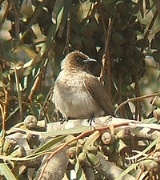
Common Bulbul
Encyclopedia
The Common Bulbul is a member of the bulbul
family of passerine
bird
s. It is a ubiquitous resident breeder throughout Africa
. Other names include Black-eyed Bulbul and Common Garden Bulbul.
The Common Bulbul has a number of subspecies; some authorities consider P. b. dodsoni (Dodson’s Bulbul), P. b. somaliensis (Somali Bulbul) and P. b. tricolor (Dark-capped Bulbul) as separate species from the nominate P. b. barbatus.
The Dark-capped Bulbul is mostly greyish-brown above and whitish-brown below, with a distinctive dark head and pointy crest on top of the head. The back of the head merges into the brown of the back, and the chin is also blackish. The underparts are grey-brown apart from white around the vent (yellow in P. (b.) tricolor). It is about 18 cm in length, with a long tail. It has a dark brown head and upperparts. Sexes are similar in plumage.
. It is found in woodland, coastal bush, forest edges, riverine bush, montane scrub and in mixed farming habitats. It is also found in exotic thickets, gardens and parks.
This species nests throughout the year in the most tropics, elsewhere it is a more seasonal breeder with a peak in breeding co-inciding with the onset of the rainy season. The nest is fairly rigid, thick walled and cup-shaped. It is situated inside the leafy foliage of a small tree or shrub.
Two or three eggs is a typical clutch. It, like other bulbuls, is parasitised by the Jacobin Cuckoo.
The flight is bouncing and woodpecker-like
. The call is a loud doctor-quick doctor-quick be-quick be-quick.
Bulbul
Bulbuls are a family, Pycnonotidae, of medium-sized passerine songbirds. Many forest species are known as greenbuls. The family is distributed across most of Africa and into the Middle East, tropical Asia to Indonesia, and north as far as Japan. A few insular species occur on the tropical islands...
family of passerine
Passerine
A passerine is a bird of the order Passeriformes, which includes more than half of all bird species. Sometimes known as perching birds or, less accurately, as songbirds, the passerines form one of the most diverse terrestrial vertebrate orders: with over 5,000 identified species, it has roughly...
bird
Bird
Birds are feathered, winged, bipedal, endothermic , egg-laying, vertebrate animals. Around 10,000 living species and 188 families makes them the most speciose class of tetrapod vertebrates. They inhabit ecosystems across the globe, from the Arctic to the Antarctic. Extant birds range in size from...
s. It is a ubiquitous resident breeder throughout Africa
Africa
Africa is the world's second largest and second most populous continent, after Asia. At about 30.2 million km² including adjacent islands, it covers 6% of the Earth's total surface area and 20.4% of the total land area...
. Other names include Black-eyed Bulbul and Common Garden Bulbul.
Taxonomy
The bulbuls are a widespread family of songbirds, found much over Africa and Asia.The Common Bulbul has a number of subspecies; some authorities consider P. b. dodsoni (Dodson’s Bulbul), P. b. somaliensis (Somali Bulbul) and P. b. tricolor (Dark-capped Bulbul) as separate species from the nominate P. b. barbatus.
Identification
The bill is fairly short and straight. The bill, legs and feet are black and the eye is dark brown with a dark eye-ring, which is not readily visible.The Dark-capped Bulbul is mostly greyish-brown above and whitish-brown below, with a distinctive dark head and pointy crest on top of the head. The back of the head merges into the brown of the back, and the chin is also blackish. The underparts are grey-brown apart from white around the vent (yellow in P. (b.) tricolor). It is about 18 cm in length, with a long tail. It has a dark brown head and upperparts. Sexes are similar in plumage.
Habitat and breeding
It is a common resident breeder in much of AfricaAfrica
Africa is the world's second largest and second most populous continent, after Asia. At about 30.2 million km² including adjacent islands, it covers 6% of the Earth's total surface area and 20.4% of the total land area...
. It is found in woodland, coastal bush, forest edges, riverine bush, montane scrub and in mixed farming habitats. It is also found in exotic thickets, gardens and parks.
This species nests throughout the year in the most tropics, elsewhere it is a more seasonal breeder with a peak in breeding co-inciding with the onset of the rainy season. The nest is fairly rigid, thick walled and cup-shaped. It is situated inside the leafy foliage of a small tree or shrub.
Two or three eggs is a typical clutch. It, like other bulbuls, is parasitised by the Jacobin Cuckoo.
Behaviour
The Black-eyed Bulbul is usually seen in pairs or small groups. It is a conspicuous bird, which tends to sit at the top of a bush. As with other bulbuls they are active and noisy birds.The flight is bouncing and woodpecker-like
Woodpecker
Woodpeckers are near passerine birds of the order Piciformes. They are one subfamily in the family Picidae, which also includes the piculets and wrynecks. They are found worldwide and include about 180 species....
. The call is a loud doctor-quick doctor-quick be-quick be-quick.
External links
- Common Bulbul videos, photos & sounds on the Internet Bird Collection
- Common Bulbul on avibase
- Common Bulbul on IBC

